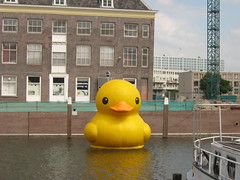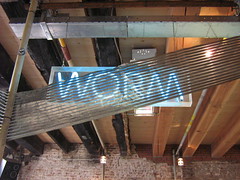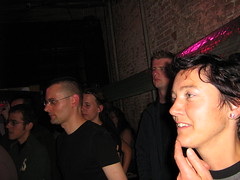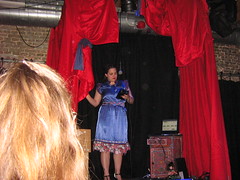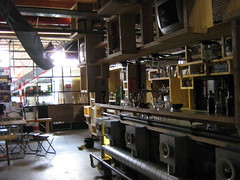Now I will also finally finish writing about my meeting with Hajo, which I only half-covered before it was time for me to leave the Netherlands, and I’m anxious to get it all down. –I’m sure at least a few other people will write about the conferences I attended, but I’m the only one who spoke with Hajo and it was such a great conversation that I think it would would be much worse to leave that undone. Plus I enjoyed the conversation so much that I really want to get back to it–in fact I’ve sort of been saving it as a treat for myself. The more I think about it, I think I have a crush on Worm. –I realize that sounds perfectly stupid, to have a crush on an organization, but I was so impressed with it that I find my self wanting to prattle on in the most ridiculous way. Apologies in advance if my prose becomes tiresomely gushy.
In the first half I wrote a lot about how people-centered Worm (and Hajo) seemed to be, but he also describes himself as a Darwinist, saying that the situation for cultural institutions in Rotterdam and in the Netherlands generally is a war and that this is good; “it keeps a alert but it’s not personal.” Hajo also feels that the competition helps the whole scene to expand and attract attention. Of course people often say that things aren’t personal when in fact they are, but in this case I was convinced that at least Hajo really felt it wasn’t personal, because when I asked if there was anything we had discussed that should not be published, he said no, it was all ok. –I know, maybe our whole conversation sounds pretty tame, but he did make some comments about the other groups that might not perceived as very, ummm, flattering. But Hajo claims that he likes his counterparts at other institutions in spite disagreeing with their approaches and attitudes, and at the same time recognizes that he and Worm are not immune from those same criticisms. As he said, “those guys at V2, they are so smaakie; we are smaakie too, but we know it….ten years from now someone might be saying ‘those guys from Worm…’ but that’s ok.” –I haven’t yet been able to find out exactly what smaakie means, but you get the picture.
In fact Hajo is trying to seed the next crop of contributors to the Rotterdam cultural scene by getting involved with the Media Design MA students from Piet Zwart, but it started pretty casually. As Hajo put it, they were working with Piet Zwart because of people. First of all because he and Florian [Cramer] had met, hit it off and decided they would like to work together. I’ve come to realize that many many collaborations start this way in both the academy and the art world, and I suppose it’s no surprise. To succeed, people have to work very closely toward shared goals, so I think it’s natural and helpful to work with people you like and with whom you share at least some ideas. Anyway, Hajo and Florian started talking and this is the first project. For Hajo it brings new blood into Worm; some of the students may decide to work or perform here later. Hajo is also always looking for new ideas, to see something new that they can combine with something old in public programs to inspire people. Hajo is always asking “what can we learn from past innovations to inspire new ones?”
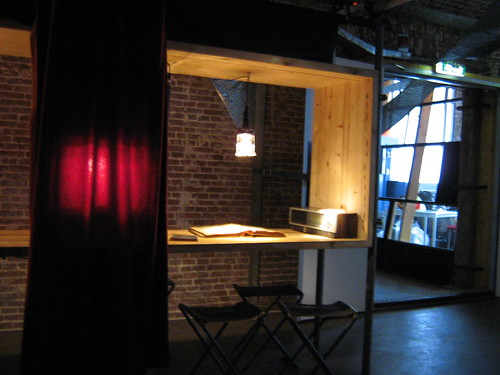
To the right you see Audrey Samson’s graduation project, ‘spectres’? as it was installed at Worm, 7/7/07.
He goes on to say that “I want to contribute as much as we can…making it [new technology] into a social context, interesting, being an ambassador, making it[computers] into a normal field.”
Hopefully in a few years the students can contribute something back to the field. This is a long term investment for Hajo because he believes you have to be a little older to be radical. At first this sounds counter-intuitive because young people are often assumed to be radical by nature, but I think he’s right. It takes experience to know where the boundaries are and what would be a real innovation.
At this point in the interview, Marco, who does all the accounting, walked by and commented jokingly that the people at Worm are technocratic conservatives, but with love. Hajo laughed and agreed; they try to leave good things in place and alter the bad things. They don’t follow trends just for the sake of them, so they are multidisciplinary not as a goal, but as a practice. Their experiments have taught them that a party can be a medium; so can a meeting. So they will use whatever media best let them explore a possibility and bring it to people–in this way they are “radically pragmatic.” This holistic approach means that rather than regarding meetings as a necessary evil or parties as merely celebration after the fact, both are an integral of the discovery process.
This sounds like a productive way of working, but also perhaps more challenging. I asked Hajo what the biggest challenge was, especially when collaborating with another institution. After some thought, he replied that “dealing with really talented people means making a structure in which they can operate.” In this instance of collaboration with Piet Zwart, some of the people working at Worm stayed up all night once or twice to help students who (proving that there at least some universals) needed to do a lot of work at the last minute. Hajo asked them how they felt about that, if it had been fun to work in that intensive way and apparently it had been.

Here Florian talks a member of Worm in the the Wormshop about possibilities for future collaboration. I was impressed by how open everything was; they all just did their business as usual, even though I was just hanging around snapping pictures, a stranger to everyone except Florian.
Worm is not a rich organization; they started as an artists’ squat and now depend mainly on grants from foundations and the government to support more ambitious projects, so they have to think about their spending priorities. This is another way they work on providing a structure–“so the office is crap, but the performances are good. Eventually they will get fed up with the office and fix it.” Again, it depends on what the people working at and with Worm most need.
The group has worked in several locations before moving to their current space in an historic building in Delfshaven that presented quite a challenge. Because it is protected as a historic monument, Worm could not make any structural changes except those required by fire codes, so they took a novel approach to constructing their space. Working with architects who followed the principle of “superuse,” they constructed a new interior structure entirely from salvaged material, and all either free-standing or attached only to a metal frame made with clamps braced between the walls, floors and ceilings. This frame is held in place only by pressure, it is not fastened to the building’s structure. (For more on the construction, read about it in the Superuse book, or visit the 2012 Architects’ Worm set on Flickr.)
Hajo likes the space but is not especially attached to it and had thought that it would be fine if they had to move when the city finally decided what to do with the building. But, he discovered during the weekend of the graduation show that some of his colleagues had come to really care about the building, and didn’t want to juts give it up. So now Hajo is working on a proposal to buy the building, because he wants the people he works with to stay and be happy, and to do that, they need to have a more permanent home.
Given his other beliefs, it’s not surprising that Hajo prefers a DIY approach, but he also has pragmatic reasons as well. Superuse is not only environmentally sound, but is significantly cheaper, just as switching to Linux allowed Worm to operate with a collection of salvaged computers without having compatibility issues. But this also allows them to be “masters of new technology rather than slaves.”
At the same time, Worm no longer works outside the system. When talking about the difficulty more radical groups have with a transition to working with the system as they become more established, Hajo exclaimed “don’t complain about the system if you aren’t taking part in the system.” Worm maintains a balance between a DIY approach and being a regular institution. “If freedom is 0–>100, we are 85, and this is a success. That freedom allows them to present acts, artists, films, or speakers that might only attract a few people, and count them as successes if they are interesting, rather than measuring success only by numbers in the audience or money in the till. Measuring success also takes time; Worm started the practice of “Live Cinema” which is occurs in venues all over the world. In that way it was a great success, but no one remembers that it started at Worm. But in Hajo’s words, “if you really do something, you make a difference and that makes it fun.”
